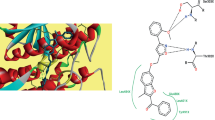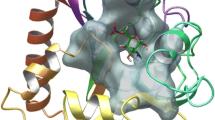Abstract
Design, synthesis, and antibacterial activities of a series of arylsulphonamide derivatives as probable peptide deformylase (PDF) inhibitors have been discussed. Compounds have been designed following Lipinski’s rule and after docking into the active site of PDF protein (PDB code: 1G2A) synthesized later on. Furthermore, to assess their antibacterial activity, screening of the compound was done in vitro conditions against Gram-positive and Gram-negative bacterial strains. In silico, studies revealed these compounds as potential antibacterial agents and this fact was also supported by their prominent scoring functions. Antibacterial results indicated that these molecules possessed a significant activity against Staphylococcus aureus, Bacillus cereus, Pseudomonas aeruginosa, and Escherichia coli with MIC values ranging from 0.06 to 0.29 μM. TOPKAT results showed that high LD50 values and the compounds were assumed non-carcinogenic when various animal models were studied computationally.






Similar content being viewed by others
References
Silver LL (2011) Challenges of antibacterial discovery. Clin Microbiol Rev 24:71–109
Bisacchi GS, Manchester JI (2015) A new-class antibacterial-almost. lessons in drug discovery and development: a critical analysis of more than 50 years of effort toward ATPase inhibitors of DNA gyrase and topoisomerase IV. ACS Infect Dis 1:4–41
Giglione C, Pierre M, Meinnel T (2000) Peptide deformylase as a target for new generation, broad spectrum antimicrobial agents. Mol Microbiol 36:1197–1205
Leeds JA, Dean CR (2006) Peptide deformylase as an antibacterial target: a critical assessment. Curr Opin Pharmacol 6:445–452
Sangshetti JN, Khan FAK, Shinde DB (2015) Peptide deformylase: a new target in antibacterial, antimalarial and anticancer drug discovery. Curr Med Chem 22:214–236
Zhengyu Y, Joaquim T, Richard JW (2001) Deformylase as a novel antibacterial target. DDT 6:954–961
Verma SK, Jat RK, Nagar N, Saharan R, Sharma V, Pandey S, Bansal KA (2011) Novel antibacterial target: peptide deformylase. Pharmacophore 2:114–123
Guay DRP (2007) Drug forecast—the peptide deformylase inhibitors as antibacterial agents. Ther Clin Risk Manag 3:513–525
Boularot A, Giglione C, Peti S (2007) Discovery and refinement of a new structural class of potent peptide deformylase inhibitors. J Med Chem 50:10–20
Sheth A, Alvarez SE, Gardner J, Ran L, Heaney ML, Scheinberg DA (2014) Inhibition of human mitochondrial peptide deformylase causes apoptosis in c-myc-overexpressing hematopoietic cancers. Cell Death Dis 5:1–9
Butler D, Chen D, Dwyer KO, Lewandowski T, Aubart K, Zalacain M (2014) Potent sub-MIC effect of GSK 1322322 and other peptide deformylase inhibitors on in vitro growth of Staphylococcus aureus. Antimicrob Agents Chemother 58:290–296
Chen C, Wang T, Wu F, Huang W, He G, Ouyang L, Xiang M, Peng C, Jiang Q (2014) Combining structure-based pharmacophore modeling, virtual screening, and in silico ADMET analysis to discover novel tetrahydro-quinoline based pyruvate kinase isozyme M2 activators with antitumor activity. Drug Des Dev Ther 8:1195–1210
Green BG, Toney JH, Kozarich JW, Grant SK (2000) Inhibition of bacterial peptide deformylase by biaryl acid analogs. Arch Biochem Biophys 375:355–358
Huntington KM, Yi T, Wei Y, Pei D (2000) Synthesis and antibacterial activity of peptide deformylase inhibitors. BioChemistry 39:4543–4551
Apfel CM, Banner DW, Bur D, Dietz M, Hirata T, Hubschwerlen C, Locher H, Page MGP, Pirson W, Rossé G, Specklin JL (2000) Hydroxamic acid derivatives as potent peptide deformylase inhibitors and antibacterial agents. J Med Chem 43:2324–2331
East SP (2014) Actinonin and analogs: inhibitors of bacterial peptide deformylase. In: Marinelli F, Genilloud O (eds) Antimicrobials: new and old molecules in the fight against multi-resistant bacteria. Springer, Berlin, Heidelberg, pp 287–305. ISBN:978-3-642-39967-1 (Print), 978-3-642-39968-8$4 (Online)
Hansch C, Sammes PG, Taylor JB (1990) Comprehensive medicinal chemistry, vol 2, Chap. 71. Pergamon Press, Oxford
Kanda Y, Kawanishi Y, Oda K, Sakatab T, Mihara S, Asakura K, Kanemasa T, Ninomiya M, Fujimoto M, Kanoike T (2001) Synthesis and structure–activity relationships of potent and orally active sulphonamide ETB selective antagonists. Bioorg Med Chem 9:897–907
Stokes SS, Albert R, Buurman ET, Andrews B, Shapiro AB, Green OM, McKenzie AR, Otterbein LR (2012) Inhibitors of the acetyltransferase domain of N-acetylglucosamine-1-phosphate-uridylyltransferase/glucosamine-1-phosphate-acetyltransferase (GlmU). Part 2: optimization of physical properties leading to antibacterial aryl sulphonamides. Bioorg Med Chem Lett 22:7019–7023
Singh A, Yadav M, Singh P, Srivastava R, Singh N, Verma R, Singh RK (2014) N-Heterocyclic analogues as peptide deformylase inhibitors: Molecular modeling, synthesis and antibacterial evaluation. BMC Infect Dis 14:E18
Chibale K, Haupt H, Kendrick H, Yardley V, Saravanamuthu A, Fairlamb AH, Croft SL (2001) Antiprotozoal and cytotoxicity evaluation of sulphonamide and urea analogues of quinacrine. Bioorg Med Chem Lett 11:2655
Ezabadi IR, Camoutsis C, Zoumpoulakis P, Geronikaki A, Sokovic M, Glamocilija J, Ciric A (2008) Sulphonamide-1,2,4-triazole derivatives as antifungal and antibacterial agents: Synthesis, biological evaluation, lipophilicity, and conformational studies. Bioorg Med Chem 16:1150
Kennedy JF, Thorley M (1999) Bioseparation. In: Kleeman A, Engel J, Kutscher B, Reichert D (eds) Pharmaceutical Substances, 3rd edn, vol 8. Thieme, Stuttgart, pp 336
Serradeil-Le Gal C (2001) An overview of SR121463, a selective non-peptide vasopressin V2 receptor antagonist. Cardiovasc Drug Rev 19:201
Natarajan AY, Harbinski F, Fan YH, Chen H, Luus L, Diercks J, Aktas H, Chorev M, Halperin JA (2004) Novel arylsulfoanilide-oxindole hybrid as an anticancer agent that inhibits translation initiation. J Med Chem 47:4979
Vullo D, Luca VD, Scozzafava A, Carginale V, Rossi M, Supuran CT, Capasso C (2013) Anion inhibition studies of the α-carbonic anhydrase from the pathogenic bacterium Vibrio cholera. Bioorg Med Chem 21:4521
Wilson CO, Gisvold O, Block JH (2004) Wilson and Gisvold’s textbook of organic medicinal and pharmaceutical chemistry, 11th edn. In: Block J, Beale JM (eds) Lippincott Williams and Wilkins, Philadelphia, p 11
Kim DK, Lee JY, Lee N, Ryu DH, Kim JS, Lee S, Choi JY, Ryu JH, Kim NH, Im GJ, Choi WS, Kim TK (2001) Synthesis and phosphodiesterase inhibitory activity of new sildenafil analogues containing a carboxylic acid group in the 5′-sulphonamide moiety of a phenyl ring. Bioorg Med Chem 9:3013
Roush WR, Gwaltney SL, Cheng J, Scheidt KA, McKerrow JH, Han E (1998) Vinyl sulfonate esters and vinyl sulphonamides: potent, irreversible inhibitors of cysteine proteasessell. J Am Chem Soc 120:10994–10995
Ma T, Fuld AD, Rigas JR, Hagey AE, Gordon GB, Dmitrovsky E, Dragnev KH (2012) A phase I trial and in vitro studies combining ABT-751 with carboplatin in previously treated non-small cell lung cancer patients. Chemotherapy 58:321
Ogden RC, Flexner CW (2001) Protease inhibitors in AIDS therapy. In: Dekker M (ed) Informa Health Care. New York, Basel, pp 27–48
Lipinski CA, Lombardo F, Dominy BW, Feeney PJ (2001) Experimental and computational approaches to estimate solubility and permeability in drug discovery and development settings. Adv Drug Deliv Rev 46:3–26
RSCB protein Data Bank. http://www.rcsb.org/pdb. Accessed 27 July 2013
Dardel F, Ragusa S, Lazennec C, Blanquet S, Meinnel T (1998) Solution structure of nickel-peptide deformylase. J Mol Biol 280:501–513
Muegge I, Martin YC (1999) A general and fast scoring function for protein–ligand interactions: a simplified potential approach. J Med Chem 42(5):791–804
Lagos CF, Caballero J, Gonzalez-Nilo FD, Mahana DPC, Perez-Acle T (2008) Docking and quantative structure–activity relationship studies for the Bisphenylbenzimidazole family of non-nucleoside inhibitors of HIV-1 reverse transcriptase. Chem Biol Drug Des 72:360–369
Singh A, Yadav M, Srivastava R, Singh N, Kaur R, Gupta SK, Singh RK (2016) Design and anti-HIV activity of arylsulphonamides as non-nucleoside reverse transcriptase inhibitors. Med Chem Res. 25:2842–2859.
National Committee for Clinical Laboratory Standards (1982) Standard methods for dilution antimicrobial susceptibility test for bacteria which grow aerobically, Villanova, Pa. NCCLS, p 242
Egan WJ, Merz KM Jr, Baldwin JJ (2000) Prediction of Drug Absorption Using Multivariate Statistics. J Med Chem 43:3867–3877
Venkataramana CHS, Ramya SKM, Singh SS, Madhavan V (2011) In-silico ADME and toxcity studies of some novel indole derivatives. JAPS 10:159–162
Varma RS (2001) Solvent-free accelerated organic syntheses using microwaves. Pure Appl Chem 73:193–198
Caddick S (2001) Thionation of amides using Lawessons reagent; Thioamides. Synthetic 66. doi:10.1039/SP66
Pathak U, Pandey LK, Tank R (2008) Expeditious microwave-assisted thionation with the system PSCl3/H2O/Et3N under solvent-free condition. J OrgChem 73:2890–2893
Kaboudin B, Malekzadeh L (2011) Ammonium phosphorodithioate: a mild, easily handled, efficient, and air-stable reagent for the conversion of amides into thioamides. Synlett 2011:2807–2810. doi:10.1055/s-0031-1289859
Lee HJ, Choi YS, Lee KB, Park J, Yoon CJ (2002) Hydrogen bonding abilities of thioamide. J Phys Chem A 106:7010–7017.
Acknowledgements
Financial assistance in the form of WOS-A fellowship (SR/WOS-A/CS-1053/2014) to Anuradha Singh by the DST, New Delhi is sincerely acknowledged.
Author information
Authors and Affiliations
Corresponding author
Ethics declarations
Conflict of interest
The author(s) declare no competing interests.
Rights and permissions
About this article
Cite this article
Singh, A., Srivastava, R. & Singh, R.K. Design, Synthesis, and Antibacterial Activities of Novel Heterocyclic Arylsulphonamide Derivatives. Interdiscip Sci Comput Life Sci 10, 748–761 (2018). https://doi.org/10.1007/s12539-016-0207-2
Received:
Revised:
Accepted:
Published:
Issue Date:
DOI: https://doi.org/10.1007/s12539-016-0207-2




